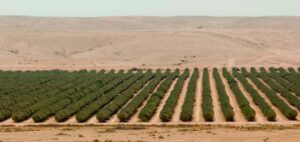
Preface. Irrigated agriculture over 58 million acres consumes the largest share of U.S. water. And it’s shrinking as aquifers are drained, reservoirs evaporate, and drought reduces snowpack and rainfall at the same time population and the economy are growing. My books explain why the electric grid can’t stay up without fossil fuels (or transportation and manufacturing), so irrigation won’t survive either.
According to the 2018 Irrigation and Water Management Survey, more than half of all water applied as irrigation came from surface water with the remaining water obtained from groundwater sources. That’s not good news, California grows a quarter of America’s food, but the aquifers may run out of water in the 2030s (AGU 2016). Many of the states below are above the Ogallala aquifer, where a third of America’s food is grown, and it too is emptying out rapidly (Konikow 2013).
Twenty states consume 90% of irrigation water as follows: Nebraska 14.8%, California 13.5%, Arkansas 8.4%, Texas 7.5%, Idaho 5.9%, Kansas 4.3%, Montaina 3.6%, Mississippi 3.1%, Washington & Oregon 2.9%, Wyoming, Missouri, and Florida 2.6%, Georgia & Louisiana 2.1%, Utah 1.9%, Arizona 1.6%, nevada 1.4%, Michigan 1.2% and the reset of the states 10.1%.
Corn used the most irrigated acreage in the U.S. — 12 million — and soybeans second with 9 million acres. These crops also erode more topsoil, cause more greenhouse gases, and need more fossil fuels, pesticides and fertilizers than other crops (Friedemann 2021).
As you’ll see below, pumping up this water takes quite a bit of electricity. Which at some point of energy decline, will not always be available and ultimately non-existent. Then you’ll wish you lived in a state where crops can be grown with rainfall. We won’t be irrigating more land…
Alice Friedemann www.energyskeptic.com Author of Life After Fossil Fuels: A Reality Check on Alternative Energy; When Trucks Stop Running: Energy and the Future of Transportation”, Barriers to Making Algal Biofuels, & “Crunch! Whole Grain Artisan Chips and Crackers”. Women in ecology Podcasts: WGBH, Jore, Planet: Critical, Crazy Town, Collapse Chronicles, Derrick Jensen, Practical Prepping, Kunstler 253 &278, Peak Prosperity, Index of best energyskeptic posts
***
Dinneen J (2022) Half of newly irrigated land is in water-stressed areas Irrigating more land could help feed 1.4 billion people, but over half of new irrigation projects are in places that are already at risk of running dry. NewScientist.
The world’s irrigated land has grown by more than 116,000 square miles (300,000 square km) since 2000. More than half of that increase occurred in places that lack enough water to irrigate without eventually running dry. Around 90 per cent of all fresh water used by people goes toward irrigation, and irrigated lands produce food for 3.4 billion people. Irrigating rain-fed cropland could help grow food for an additional 1.4 billion people, and also help farmers adapt to climate change, says Lorenzo Rosa at Stanford University in California. But irrigation in places without enough water can deplete stores, threatening water security.
Between 2000 and 2015, the overall amount of irrigated land increased by 11% to 3.3 million square km. The greatest increase was in China, followed by India, then water-rich Brazil, where irrigated land more than doubled. Several regions saw a decrease in irrigation, including the drought-stricken western US, northern China and parts of Pakistan. Russia’s irrigated land declined by half.
The researchers then examined the amount of water available in these irrigated places as of 2000, considering both rainfall and groundwater. Of the places where irrigation increased, 52% did not have enough water to support the new irrigation without eventually depleting available stores. Measured against a warmer climate, the amount of unsustainable irrigation is likely even greater.
While much of the expansion in China, Egypt, Iran, Thailand and a number of other countries was unsustainable, the largest unsustainable expansion was in India – the country accounted for more than a third of all unsustainable new irrigation across the globe, notably in the fertile North Indian Plain. Reference: eartharxiv.org/repository/view/3512/
***
USEIA (2014) Many industrial electricity customers are farmers. United States Energy Information Administration.

Farmers make up a significant share of industrial electricity customers in certain states. This is because of demand from farm irrigation systems. For example, Nebraska is largely rural and agricultural, but it has the third-highest count of industrial electricity customers in the United States. The same factor drives up the number of industrial electricity customers in Idaho and Kansas, which are also among the top 10 states in number of industrial electricity customers.
Irrigation load from farm irrigation systems can be costly to serve, because of the high cost of connecting these dispersed systems to the electric grid and the high cost of having enough capacity available to meet seasonal irrigation load.

One Response to Can we grow enough food postcarbon? Irrigation needs water & electricity